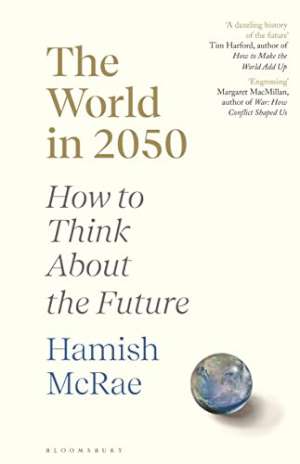25 July 2022
The World in 2050
How to Think About the Future
Hamish McRae
2022, Bloomsbury, 371 pages,
ISBN 1526600080
Reviewer: Ian Harwood

“Forecasting is difficult- especially about the future” is an amusing aphorism attributed to a variety of authors. Nonetheless, peoples’ actions are necessarily guided by a view of what the future may hold. Accordingly, there a persistent and insatiable hunger for insights on this score. Weather forecasters and economists play key roles in satisfying this demand , albeit over limited time-horizons. As far as the much longer-term outlook is concerned, it is those who practice futurology who step up to provide a hopefully helpful vision.
Hamish McRae, the author of this book, has built and maintained an estimably high reputation n as an economic and financial commentator over an impressively lengthy period of time. His regular journalism is unfailingly insightful and, therefore, always well worth reading. McRae does, moreover, have past form as a purveyor of longer-term “futurological” thinking insofar as almost thirty years ago he published the ground-breaking “The World in 2020”. This I recall as proving enormously useful in enhancing my thinking about how the global economy and financial system might evolve over the turn of the century and beyond. Importantly, I feel exactly the same way about McRae’s new magnum opus.
Crucially, McRae’s book has nothing in common with the “doom and gloom” or “end is nigh” analytical genre which proves (much to my chronic bemusement) so enduringly popular. Instead, McRae displays an unashamed optimism about the world’s capacity for improvement. Early in the book he emphasises quite how far humanity has progressed in recent decades and cites, in this regard, Barack Obama’s famous September 2016 talk which cut directly to the heart of this particular matter with the rhetorical Q&A: “when in human history would be the best time to be born? The time would be now. The world has never been healthier. It’s never been wealthier. It’s never been better educated. It’s never been less violent, more tolerant, than it is today.” (p 31). Indeed, the human species’ potential to improve its lot considerable further is the overarching theme which underpins McRae’s overall analysis and is neatly epitomised by his statement: “Ultimately, to be despondent is to ignore the ingenuity and adaptability of humankind.” (p115).
Importantly, this is a book which – like its predecessor – is wholly global in its scope. Far from being focused exclusively upon the outlook for the US or Europe, for instance, it covers each and every region that comprises the jigsaw which collectively comprises the global economy.
McCrae commences his oeuvre with a whistle-stop tour of the “the world we live in now” which very effectively sets the stage for what follows. He then identifies five pivotal “forces for change” –demography (he coins a new phrase: “coping with demography is destiny”); resources and the environment (with an especial focus upon climate change); trade and finance; technology; and governments and governance – which will collectively drive his crystal ball gazing.
McRae’s discussion of these multiple “forces for change” is wide-ranging and fascinating. He then moves on to a wide-ranging deliberation about “how the world will look in 2050”. Throughout, however, he emphasises the critical role of choice. Everything could go well, thereby vindicating faith in sustained human progress. Conversely, much could go wrong, with the world failing to fulfil its potential and dashing the future prospects of so many of the world’s expanding population (the United Nations’ World Population Prospects, which McRae employs, envisages our total population rising from just over 8 billion at present to 10 billion in thirty years’ time). McRae’s concluding chapter – The Big Themes That Will Shape The World Ahead” – focuses constructively upon what might go wrong (ten key issues) and, subsequently, what is likely to go right.
Many of McRae’s conclusions may seem provocative. He is sanguine, for instance, that the US will eventually successfully weather its current political and social discontent. He’s also notably upbeat about the prospects for the UK and Ireland. He’s optimistic that globalisation has yet reached the end of the road, while sceptical that we can avoid another financial crisis (Charles Kindleberger’s “hardy perennial”) and unpersuaded the Euro will survive. Furthermore, he’s strikingly upbeat about the future growth potential of India and Africa.
This is a book which can be wholeheartedly recommended. It is highly readable, and a Cornucopia of well-reasoned, insightful analysis. Its time-horizon, moreover, is very considerably longer than that with which most of us are accustomed to deal on a daily basis and is, for this reason, exceptionally stimulating.
